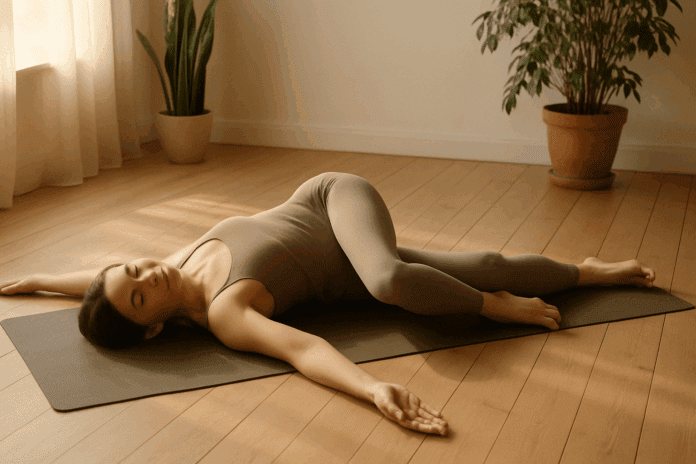Lower back pain is one of the most prevalent musculoskeletal complaints worldwide, often exacerbated by sedentary lifestyles, poor posture, and repetitive stress. While pharmacological interventions and physical therapy remain cornerstones of treatment, an increasing body of evidence supports the efficacy of mindful movement practices, such as yoga-based stretching, in managing and preventing lower back discomfort. Among these, the gentle lower back twist stretch stands out as a deceptively simple yet profoundly effective technique for relieving tension and promoting spinal mobility. This article explores the physiological benefits, proper techniques, safety guidelines, and long-term implications of incorporating the back twist stretch into a daily wellness routine.
You may also like : Best Stretches for Sore Legs and Tight Thigh Muscles: How to Relieve Upper Leg Pain Safely and Naturally
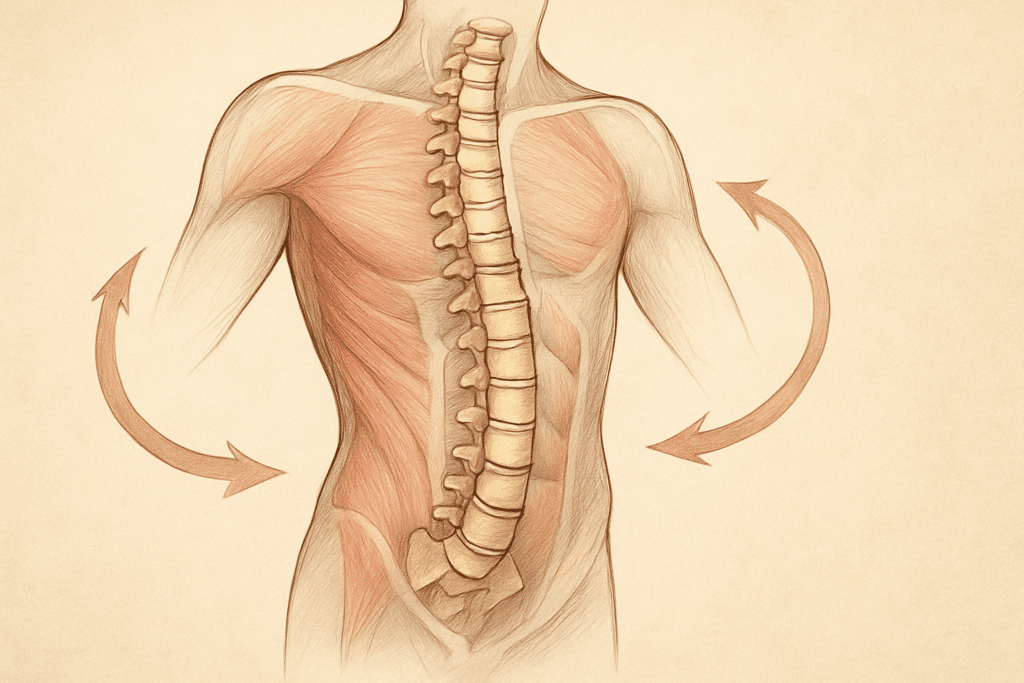
Understanding the Role of Spinal Flexibility in Back Health
Spinal flexibility is not just a marker of youth and vitality; it is central to maintaining functional independence and quality of life. The spine is designed to move in multiple directions—flexion, extension, lateral bending, and rotation. However, the modern lifestyle often limits these natural movements, resulting in muscular imbalances, fascial adhesions, and joint stiffness. A well-executed lower back twist stretch can help counteract these limitations by gently restoring rotational mobility to the thoracolumbar region. This movement not only supports dynamic posture and coordination but also facilitates nutrient exchange in the intervertebral discs, which are largely avascular and rely on movement for circulation.
Research suggests that decreased spinal rotation is linked to chronic low back pain and diminished functional capacity, especially in aging populations. Thus, targeted interventions that include twisting motions can serve as both therapeutic and preventative strategies. While strengthening the core is essential, equally important is the preservation of spinal elasticity and resilience, which can be achieved through mindful, sustained, and controlled stretches. The back twist stretch fits seamlessly into this paradigm, offering a low-impact, accessible method for fostering spinal health.

Biomechanics and Physiology of the Back Twist Stretch
The lower back twist stretch engages several anatomical structures, including the oblique abdominals, paraspinal muscles, lumbar fascia, and gluteal tissues. When performed correctly, this stretch induces a spiral line of tension along the torso, initiating a cascade of proprioceptive feedback that enhances neuromuscular coordination. Unlike aggressive spinal manipulations, the back twist stretch allows the practitioner to explore their individual range of motion with precision and control, minimizing the risk of injury.
During the stretch, the axial rotation mobilizes the facet joints of the lumbar and lower thoracic vertebrae, which are often susceptible to hypomobility due to prolonged sitting or lack of rotation in daily activities. Simultaneously, the passive stretch of the external and internal obliques encourages myofascial release, a process that can alleviate muscular tightness and improve tissue hydration. This gentle torsion also stimulates the parasympathetic nervous system, promoting a relaxation response that can be particularly beneficial for individuals experiencing stress-related back tension.
Furthermore, the twist facilitates venous return and lymphatic drainage by activating the core musculature in a lengthened state. Over time, this can improve circulation to the lumbar spine and adjacent tissues, potentially enhancing tissue repair and resilience. These physiological changes underscore the holistic value of the lower back twist stretch in addressing both mechanical and systemic contributors to back discomfort.
Understanding Fascia and the Twisting Response
Fascia, the connective tissue that weaves throughout the body, plays a central role in the mechanics and benefits of the lower back twist stretch. This tissue forms a network of tension lines and compartments that connect muscles, bones, and organs. Twisting movements activate spiral lines of fascia, particularly those running from the shoulder to the opposite hip, creating a complex web of tension and release.
This fascial response contributes to the “myofascial unwinding” that many practitioners describe during sustained twists. Over time, the slow, sustained tension can help rehydrate the fascia, release adhesions, and increase glide between fascial layers. This is especially beneficial for individuals with fibromyalgia, postural asymmetries, or stiffness due to aging. Fascial health is increasingly recognized as a determinant of overall musculoskeletal wellness, and the back twist stretch is an excellent tool for targeted fascial release.

Supporting Emotional Release Through Twisting Movements
Emotions often reside in the body as much as in the mind. Twisting poses, particularly those involving the lower back and core, are known in somatic therapy and trauma-informed yoga to release stored emotional tension. The abdominal region is closely tied to the enteric nervous system, often called the “second brain,” and twisting this area can evoke unexpected emotional responses, including relief, catharsis, or even tears.
For individuals engaged in emotional healing, the lower back twist stretch can be a safe entry point for accessing these deeper layers. Practicing in a quiet, supportive environment with intentional breath can facilitate emotional processing and create a sense of psychological lightness. This connection between physical movement and emotional health underscores the importance of integrating body-based practices into mental health care routines.
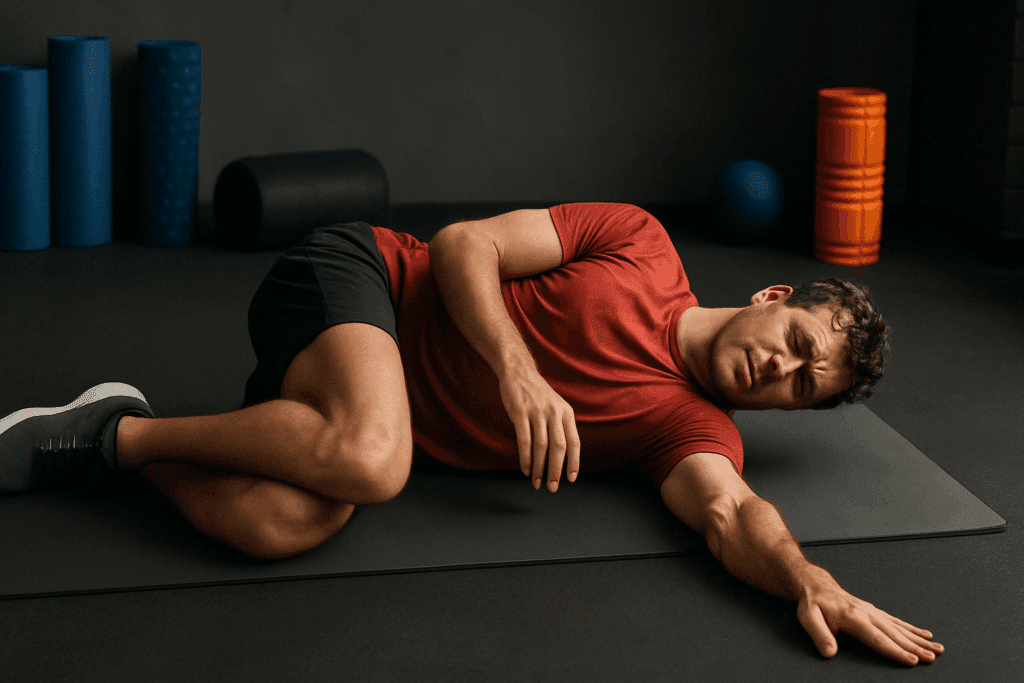
Back Twist Stretch in Sports Recovery and Injury Prevention
Athletes often overlook twisting in favor of more dynamic stretching or strength training, but the back twist stretch plays a vital role in recovery and injury prevention. Rotational movements are intrinsic to most sports, from swinging a golf club to throwing a baseball. Neglecting spinal rotation can contribute to overuse injuries, particularly in the hips, shoulders, and lower back.
Incorporating the lower back twist stretch into post-training cooldowns enhances muscle recovery by facilitating blood flow and reducing delayed onset muscle soreness (DOMS). Additionally, by improving intersegmental mobility in the spine, the stretch reduces compensatory movements in adjacent joints, preserving joint integrity over time. For runners, cyclists, and weightlifters, who often emphasize sagittal plane movement, the twist provides essential transverse plane integration.
Combining Twisting with Strength Training for Functional Integration
While the lower back twist stretch is typically classified as a flexibility exercise, it also has implications for functional strength and stability. When performed actively—using muscular engagement to enter and exit the twist rather than relying solely on gravity—the movement activates the deep core, including the transversus abdominis and multifidus muscles.
This active engagement enhances spinal stability during dynamic tasks and can be paired with resistance training for comprehensive neuromuscular integration. For example, performing a twist immediately after a core exercise like bird-dog or side plank can reinforce movement patterns and aid in recovery. As part of a prehab or rehab protocol, this approach balances flexibility with motor control, preventing hypermobility and ensuring joint integrity.
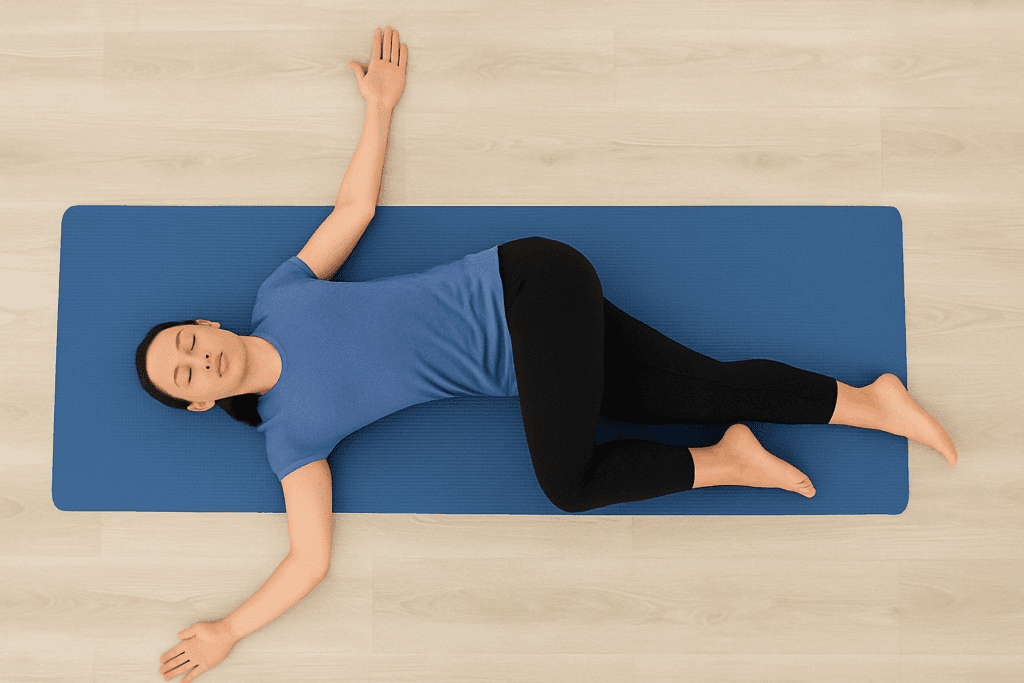
Correct Technique for Performing the Lower Back Twist Stretch
Executing the lower back twist stretch with proper form is crucial to maximizing its benefits while avoiding strain. Begin by lying supine on a firm, comfortable surface such as a yoga mat. Extend your arms out to the sides to form a “T” shape, which stabilizes the upper body and prevents overcompensation. Draw one knee toward the chest and gently guide it across the body toward the opposite side, allowing the torso to follow the twist naturally while keeping both shoulders grounded.
The key is to avoid forcing the movement. Allow gravity to facilitate the twist, and use breath as a guide. On each exhalation, deepen the rotation slightly without inducing discomfort. The gaze can be directed toward the outstretched hand on the side opposite the twist, which encourages cervical alignment and enhances the spiral effect. Hold the position for 30 to 60 seconds before returning to the neutral position and repeating on the other side.
Common mistakes include allowing the shoulder to lift off the ground, twisting from the knee rather than the torso, and holding the breath. These errors can diminish the stretch’s effectiveness and increase the risk of strain. It is also advisable to avoid this pose during acute injury or herniated disc episodes unless under professional supervision. When integrated thoughtfully, this stretch can become a cornerstone of a spinal care regimen.
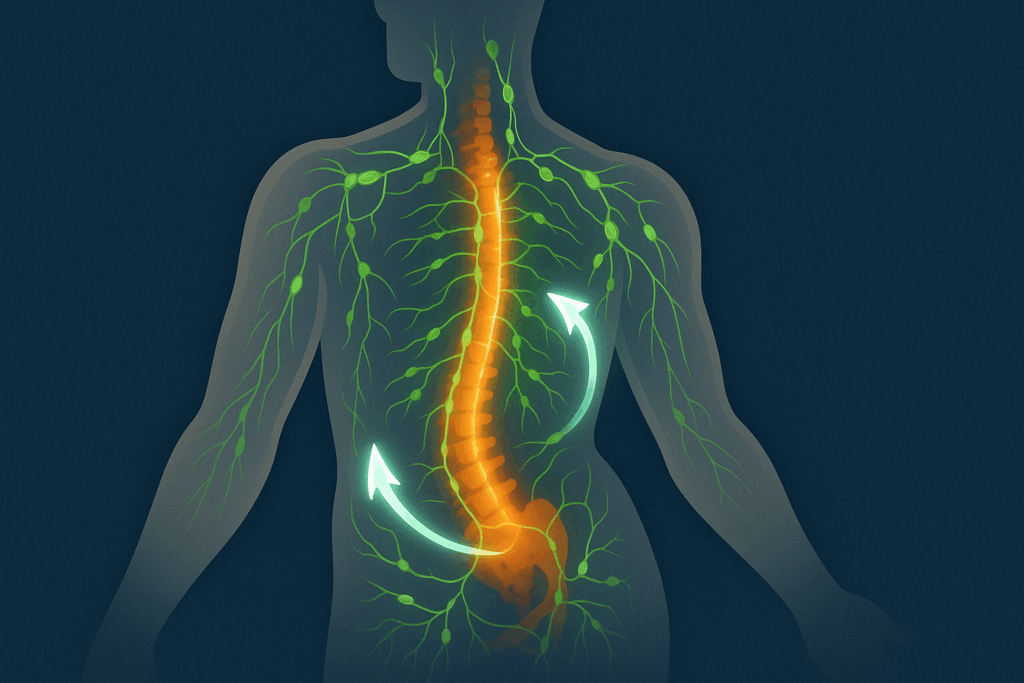
The Influence of Lower Back Twists on the Lymphatic and Immune Systems
Twisting the spine, particularly in positions that involve breath regulation and core engagement, has measurable effects on lymphatic flow. The lymphatic system lacks a central pump like the heart, and instead relies on muscular movement and diaphragmatic breathing to propel lymph through the body. The lower back twist stretch, by stimulating the thoracic and abdominal regions, can facilitate this movement.
Enhanced lymphatic drainage supports immune surveillance and helps prevent stagnation in bodily tissues. In holistic health circles, this is often associated with improved resistance to infections, reduced inflammation, and quicker recovery from minor illnesses. While more scientific research is needed to quantify these outcomes, preliminary evidence and anecdotal reports suggest that gentle, rhythmic twisting can play a supportive role in immune function.
Integrating the Back Twist Stretch with Breathwork and Meditation
Adding structured breathwork to the lower back twist stretch can amplify its benefits significantly. One technique involves using ujjayi breathing—a yogic practice characterized by a soft whispering sound generated by slightly constricting the throat. This breath enhances parasympathetic activation and deepens the twist without effort. Alternatively, diaphragmatic breathing, which encourages expansion of the belly and lower ribs, enhances the massaging effect on internal organs.
Meditative awareness can also transform the stretch from a purely physical act into a mindfulness-based practice. When attention is placed on the sensations of the twist, the movement of the breath, and the internal experience of release, the practice becomes a form of somatic meditation. This enhances neuroplasticity, emotional regulation, and overall mind-body integration, elevating the stretch beyond biomechanics into the realm of embodied self-care.
Integrating the Back Twist Stretch into a Daily Routine
To reap the long-term benefits of the lower back twist stretch, consistency is key. Unlike high-intensity workouts, gentle stretching does not necessitate a warm-up period and can be practiced upon waking, before bed, or during mid-day breaks. Incorporating the stretch into a brief morning or evening mobility routine can enhance spinal hydration and reset neuromuscular patterns conditioned by daily posture habits.
Many individuals find it beneficial to pair the back twist stretch with complementary movements such as cat-cow, child’s pose, or seated forward folds, which help to open the hips and elongate the spine. These movements create a synergistic effect, amplifying the benefits of each pose. Practicing the stretch mindfully with attention to breath and body awareness fosters a meditative quality that further supports mental well-being.
Over time, this stretch can evolve from a reactive measure for pain relief to a proactive ritual for injury prevention and performance optimization. Whether used as part of a yoga sequence, a physical therapy protocol, or a post-exercise cooldown, the gentle twist supports spinal longevity and functional resilience. Its accessibility and adaptability make it an ideal candidate for lifelong incorporation into personal wellness practices.

Safety Considerations and Modifications for All Fitness Levels
While the back twist stretch is generally safe for most individuals, there are several considerations to keep in mind to ensure a positive and productive experience. Individuals with spinal fusion, recent surgeries, herniated discs, or osteoporosis should consult a healthcare provider or physical therapist before attempting rotational movements. The degree of twist should be tailored to individual comfort and range of motion, avoiding any forced or ballistic movements.
For beginners or those with limited mobility, modifications can enhance accessibility. Placing a folded blanket or yoga block under the knee during the twist can reduce torque on the spine and provide a sense of support. Similarly, keeping the extended leg bent rather than straight can alleviate strain on the lower back and hips. Chair-based versions of the twist also offer a valuable alternative for those unable to lie on the floor.
Pregnant individuals may also benefit from gentle spinal twists but should opt for open, non-compressive variations and avoid lying supine for extended periods. In these cases, seated or side-lying twists can provide a modified experience without compromising safety. Regardless of fitness level, the emphasis should remain on quality of movement, controlled breathing, and mindful awareness rather than achieving a particular shape or depth.
Neurological and Psychological Benefits of Spinal Twisting
Beyond physical flexibility and pain reduction, the lower back twist stretch offers profound neurological and psychological benefits. The gentle torsion of the spine during twisting stimulates the vagus nerve, a critical component of the parasympathetic nervous system responsible for regulating rest-and-digest functions. Activating this nerve can induce a relaxation response that lowers heart rate, reduces stress hormones, and enhances emotional resilience.
The proprioceptive feedback elicited during the twist also supports improved body awareness, which can be particularly beneficial for individuals recovering from injury or managing chronic pain conditions. As the stretch encourages mindfulness and intentional breathing, it becomes a tool for cultivating present-moment awareness and reducing anxiety. This mind-body integration is central to many therapeutic yoga traditions and supported by contemporary neuroscience.
Studies have shown that practices involving spinal rotation can positively affect the brain’s default mode network, which is associated with self-referential thinking and rumination. By engaging in mindful movement, practitioners can disrupt unhelpful cognitive patterns and foster a greater sense of mental clarity and calm. Thus, the lower back twist stretch transcends its biomechanical function, offering a holistic pathway toward physical and psychological harmony.
Cultural and Historical Perspectives on Spinal Twisting
Spinal twisting is not a modern invention. In traditional Chinese medicine, twisting exercises appear in qigong forms designed to balance qi and harmonize organ systems. In Ayurveda and classical Hatha yoga, twists are classified as detoxifying and centering, often used to prepare the body for seated meditation. These cultural lineages provide a rich context for understanding the multidimensional nature of spinal twists.
In many indigenous cultures, spiral movement patterns are embedded in dance, ritual, and healing arts, emphasizing the cyclical and regenerative aspects of life. The modern resurgence of twisting as a therapeutic tool echoes these ancient insights, affirming that movement is not just mechanical but symbolic and transformative. Recognizing the heritage of twisting enriches its practice and invites a more respectful, embodied engagement.
Long-Term Benefits and the Science of Tissue Remodeling
One of the most compelling aspects of regularly practicing the back twist stretch is its capacity to contribute to long-term tissue remodeling. Through a process known as mechanotransduction, the gentle mechanical loading of soft tissues during stretching can stimulate fibroblasts to produce collagen and elastin, enhancing the pliability and resilience of fascial networks. This adaptation supports not only spinal health but also overall mobility and athletic performance.
Moreover, consistent stretching can lead to improved intermuscular coordination and joint proprioception, reducing the risk of injury during dynamic activities. As connective tissue quality improves, the body becomes more efficient at distributing mechanical loads, lessening the likelihood of localized strain. This redistribution of tension can relieve compensatory patterns that often contribute to chronic discomfort.
From a longevity perspective, maintaining spinal mobility through practices such as the lower back twist stretch can support healthy aging by preserving functional range of motion, balance, and postural integrity. As the spine serves as the central axis of movement and sensory integration, its care has ripple effects throughout the entire musculoskeletal and nervous systems. The science of fascia and neuromuscular adaptation increasingly points to the value of gentle, sustained stretching as a cornerstone of lifelong wellness.
Frequently Asked Questions: Gentle Back Twist Stretch and Spinal Flexibility
1. Can the lower back twist stretch improve athletic performance in rotational sports?
Yes, the lower back twist stretch can significantly enhance performance in sports that demand trunk rotation, such as tennis, golf, baseball, and swimming. While it’s commonly viewed as a gentle stretch for relaxation or mobility, this movement enhances spinal rotation and neuromuscular coordination in a way that directly translates to sport-specific actions. Regular use of the lower back twist stretch can improve the efficiency of the kinetic chain, particularly when transferring power from the hips to the upper body during explosive movements. It also serves as a valuable recovery tool, helping athletes maintain flexibility in the obliques and lumbar spine. Athletes who incorporate this stretch consistently often experience better movement fluidity and reduced injury rates related to rotational strain.
2. How does the back twist stretch affect spinal disc hydration and long-term disc health?
Spinal discs are avascular, meaning they lack direct blood supply and depend on movement and pressure variation for nutrient exchange. The back twist stretch facilitates a gentle squeezing and releasing motion across the intervertebral discs, especially in the lumbar region. This process enhances fluid dynamics and may support long-term disc hydration, a key factor in maintaining spinal integrity and preventing disc degeneration. When combined with proper hydration and a balanced movement routine, the twist becomes part of a proactive strategy for disc longevity. Over time, individuals who regularly practice the back twist stretch may experience improved disc resilience and reduced susceptibility to chronic spinal stiffness.
3. Are there psychological or emotional benefits to practicing the lower back twist stretch regularly?
The psychological effects of the lower back twist stretch are frequently underestimated. Because the movement activates the parasympathetic nervous system, it can lower cortisol levels and promote emotional calm. Practicing the stretch regularly may also improve interoception—the ability to sense internal bodily states—which is closely tied to emotional regulation. Many practitioners report feeling emotionally lighter or more centered after this stretch, especially when it is performed in a quiet space with controlled breathing. In somatic therapy contexts, the lower back twist stretch is often used to help release trauma stored in the tissues, offering a safe and embodied way to reconnect with the nervous system.
4. How does the back twist stretch interact with core stability training?
Contrary to the belief that stretching relaxes muscles in a way that might weaken them, the back twist stretch can actually reinforce core engagement when done actively. By initiating the twist from the torso rather than passively falling into it, you engage deep core stabilizers such as the multifidus and transversus abdominis. This interaction supports spinal alignment and helps reprogram motor patterns, making it easier to maintain good posture in everyday movement. Integrating the stretch after core exercises like planks or side bridges may even enhance muscular balance. This pairing creates a functional harmony between flexibility and strength that supports dynamic movement and injury prevention.
5. Is the lower back twist stretch suitable for individuals recovering from back surgery or spinal injury?
In many cases, yes—but only under medical supervision. While the lower back twist stretch can aid in gentle reintroduction of spinal rotation, its application post-surgery or injury must be highly individualized. For some patients, a modified or assisted version of the twist, such as a chair-based rotation or a supine twist with minimal range, may be beneficial during rehabilitation. The primary goal is to reestablish safe mobility without compromising the healing process. It is essential to consult a physical therapist or orthopedic specialist before incorporating this stretch into a recovery plan, especially if hardware, fusion, or nerve involvement is present.
6. How can the back twist stretch support digestion and gastrointestinal function?
The rotational pressure and release from a back twist stretch provides a mild, natural massage to the abdominal organs, including the stomach, intestines, and liver. This mechanical stimulation may support peristalsis, the wave-like motion that moves food through the digestive tract. Additionally, when combined with diaphragmatic breathing, the twist can enhance vagus nerve stimulation, indirectly supporting digestive enzyme activity and motility. Individuals who struggle with bloating, sluggish digestion, or abdominal tightness may find gentle twisting after meals particularly soothing. However, it’s best to wait at least 30 minutes to an hour after eating before practicing the stretch to avoid discomfort.
7. Can children and adolescents safely practice the lower back twist stretch, and what are the benefits?
Absolutely. The lower back twist stretch is a safe and beneficial practice for children and teens when performed with proper guidance. Young bodies are still developing coordination and neuromuscular control, and this stretch promotes proprioception and spinal awareness. It can also help offset the musculoskeletal imbalances that arise from extended screen time, heavy backpacks, or poor posture in school settings. In youth athletics, the stretch aids in flexibility for sports that involve throwing, jumping, or sprinting. Just like with adults, the key is to teach correct form and encourage mindful movement rather than pushing for extreme ranges of motion.
8. How does the back twist stretch compare with spinal manipulation techniques used by chiropractors?
While both aim to improve spinal mobility, the back twist stretch differs significantly from chiropractic adjustments in intent and execution. Spinal manipulation typically involves a high-velocity, low-amplitude thrust to a specific vertebral segment, which requires professional training and diagnosis. In contrast, the stretch promotes gradual, active range-of-motion improvement and is self-administered, making it more accessible and less forceful. For individuals seeking non-invasive, daily spinal care, the stretch offers a sustainable and low-risk method. However, when used in tandem with clinical interventions, it may help prolong the benefits of professional treatment by maintaining mobility between sessions.
9. Are there advanced variations of the lower back twist stretch for experienced practitioners?
Yes, as flexibility and body awareness improve, the lower back twist stretch can be modified to provide deeper engagement and challenge. For instance, a supine twist can be combined with leg extensions or resisted band pulls to integrate strength elements. Seated or standing spinal twists with arm reaches across the body add complexity and balance training. Yoga practitioners may also incorporate variations like revolved triangle pose or revolved chair pose to increase load and range. These progressions should be approached mindfully to avoid over-twisting or compromising spinal alignment. Proper warm-up and a foundation of core stability are essential when advancing the stretch.
10. What role does the lower back twist stretch play in aging and maintaining independence in older adults?
As we age, spinal mobility naturally declines, often contributing to balance issues, gait changes, and increased fall risk. The lower back twist stretch can help preserve rotational capacity, which is vital for functional activities like looking over the shoulder while driving, dressing, or navigating tight spaces. Regularly practicing this stretch promotes thoracolumbar rotation and helps maintain the suppleness of supporting muscles and fascia. Moreover, it offers a gentle way to reduce stiffness and support circulation in older adults who may be less mobile. When practiced regularly, the back twist stretch becomes a valuable tool for promoting independence and quality of life in aging populations.
Conclusion: Embracing the Lower Back Twist Stretch for Lifelong Flexibility and Relief
Incorporating the gentle lower back twist stretch into your wellness routine is a simple yet powerful way to support spinal flexibility, reduce muscular tension, and enhance overall vitality. Far from being a passive or trivial movement, this stretch engages the body and mind in a dynamic interplay that fosters resilience, relaxation, and reintegration. Its benefits extend beyond the spine, influencing circulatory health, stress modulation, and even cognitive clarity.
With proper technique, mindful execution, and a commitment to regular practice, the back twist stretch becomes more than just a remedy for discomfort—it evolves into a lifelong companion for maintaining physical balance and inner calm. Whether you are seeking relief from chronic tension, looking to improve mobility, or aiming to future-proof your musculoskeletal health, this stretch offers a safe, accessible, and deeply effective solution.
As more individuals turn to integrative and evidence-based approaches to health and fitness, the value of foundational practices like the lower back twist stretch becomes increasingly clear. Its ability to address both biomechanical and systemic contributors to back pain makes it an indispensable tool for modern wellness. Embrace this movement not only as a stretch, but as a ritual of care for your spine, your breath, and your entire being.
Was this article helpful? Don’t let it stop with you. Share it right now with someone who needs to see it—whether it’s a friend, a colleague, or your whole network. And if staying ahead on this topic matters to you, subscribe to this publication for the most up-to-date information. You’ll get the latest insights delivered straight to you—no searching, no missing out.
Further Reading:
Best stretches for lower back flexibility and pain relief
The 5 Best Back Stretches To Improve Back Flexibility
10 Simple Stretches to Effortlessly Ease Your Body After a Long Day

